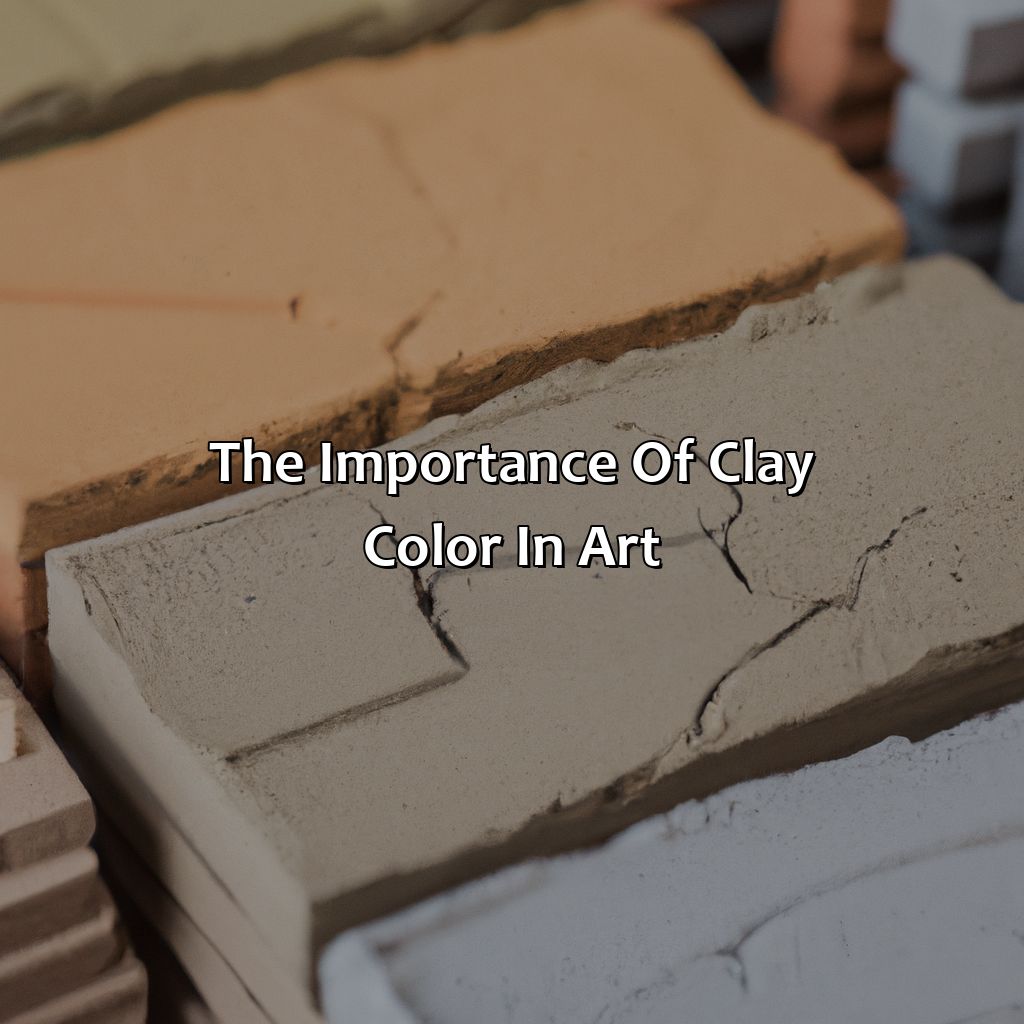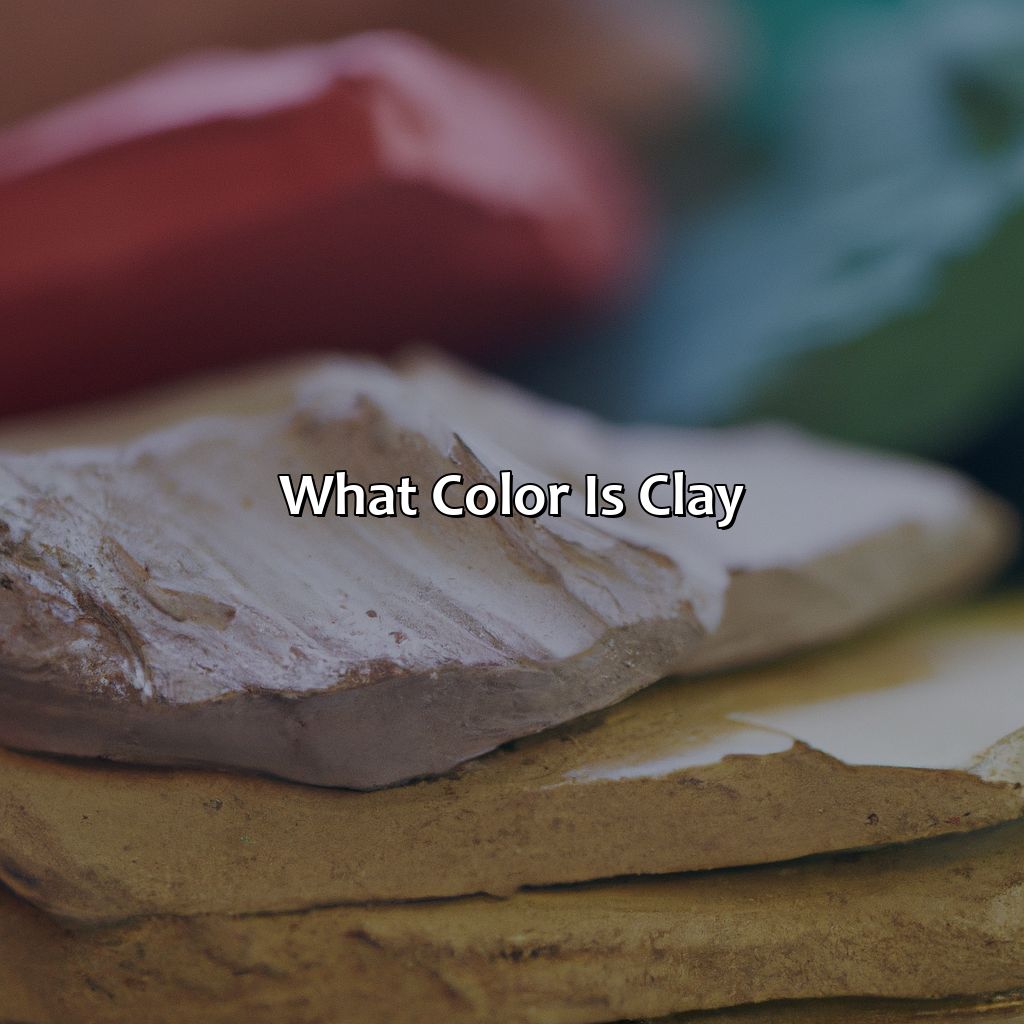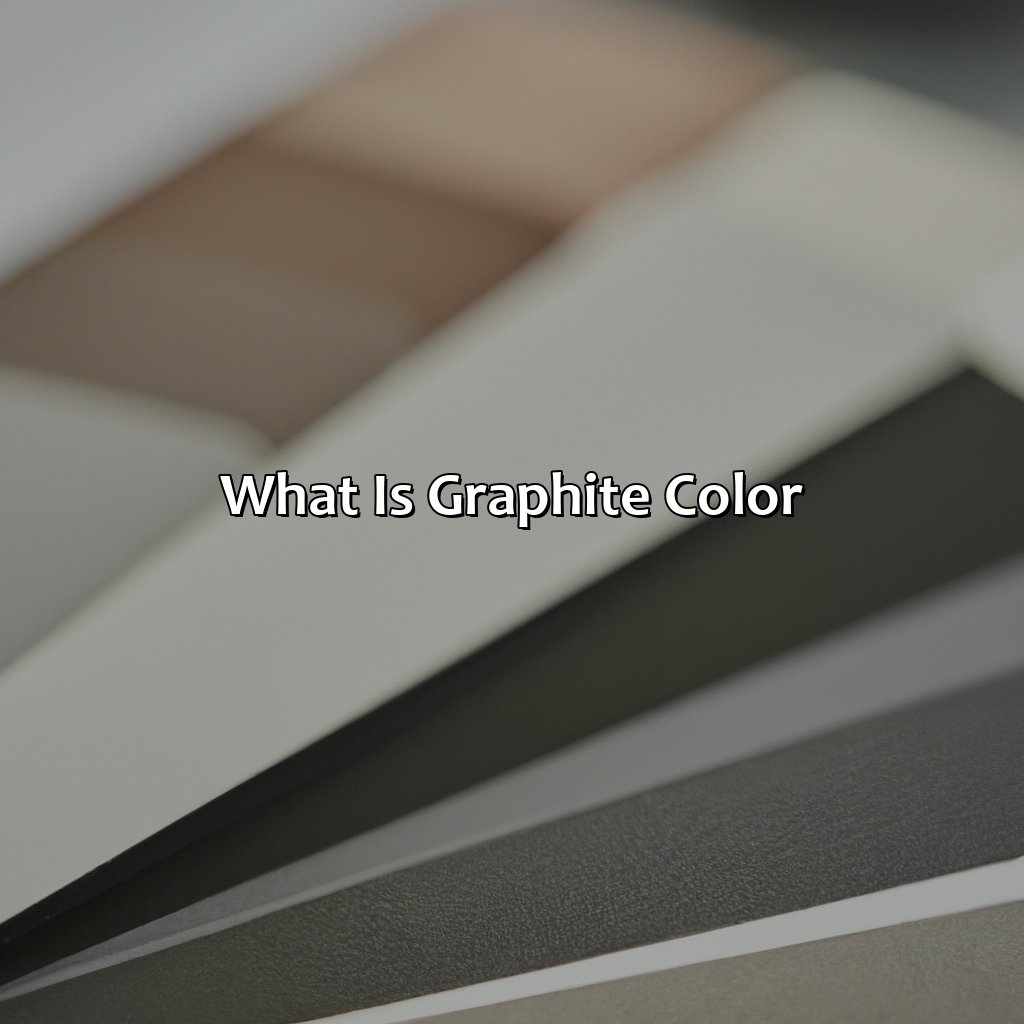Key Takeaway:
- There are different types of clay including earthenware clay, stoneware clay, and porcelain clay. Each type has its own unique properties and uses in art and pottery.
- The natural color of clay can vary depending on factors such as the type of clay, the amount of iron oxide, and the firing temperature. Red, white, buff, and yellow are common clay colors.
- Factors such as the amount of iron oxide and organic matter, as well as firing temperature, can affect clay color shades. Clay color plays an important role in art and pottery and can have symbolic and psychological meanings.
Different types of Clay

Photo Credits: colorscombo.com by Brian Hill
To grasp the various kinds of clay, such as earthenware, stoneware, and porcelain clay, you need to research their unique qualities. Explore these components for a thorough comprehension of what makes each type of clay distinct and how they are used in pottery and other creative endeavors.
Earthenware clay
Earthenware Clay Characteristics
| Characteristics | |
|---|---|
| Composition | Typically contains more organic matter |
| Firing Temperature | Lower firing temperature than stoneware |
| Color | Reddish brown due to iron oxide content |
| Physical Properties | Soft and brittle when unfired |
Earthenware clay has a unique texture that makes it ideal for hand-building or wheel-throwing techniques. Its porous surface is useful for decorative purposes too, since it accepts marks and patterns well. The term ‘earthenware’ comes from the fact that it’s made from earth or soil extracted from riverbanks.
Historically, earthenware clay was integral to the creation of most functional household items such as pots, pans, water vessels etc. because it can withstand heat resistance up to a certain extent. Even today, artisans use earthenware clay to create beautiful pottery items with different techniques varying across cultures all over the world.
Not all clay is created equal, but stoneware clay is definitely the tough guy in the pottery world.
Stoneware clay
This type of clay is ideal for wheel-throwing, hand-building and sculpting. When fired at high temperature, stoneware clay becomes non-porous and can be glazed or left unglazed as per the artist’s preference. Due to its characteristics, stoneware clay has become increasingly popular among artists and potters around the world.
Notably, stoneware clay also comes in different colors that range from grayish-brown to deep brown hues. Some variants may have speckled patterns or veining effects on them due to their mineral composition. These unique features make every piece created from stoneware clay one-of-a-kind.
To explore this versatile material further, artists can experiment with different glazes and surface treatments to create truly unique pieces. So if you’re an aspiring artist or someone looking for functional tableware that lasts long, using stoneware clay might just be your perfect choice!
Porcelain clay is like the high-maintenance friend you love to have around: it requires special treatment to look its best.
Porcelain clay
However, working with porcelain clay can be quite different from other clays as it requires specific techniques due to its unique properties. For instance, due to its fine nature, it dries up faster than other types of clay so artists must work in mindfulness to avoid cracks or defects in the product.
Aside from its renowned white color, artists can alter the color of porcelain clay by incorporating natural materials during the firing process without compromising on its quality such as through adding iron oxide which creates an attractive speckled finish or metallic nuances as well as better functionality in some products.
If one intends to use porcelain clay for their crafts; experts suggest preparing their workspace properly and keeping all tools clean to prevent contamination because even a single impurity can affect the entire batch resulting in significant failures.
Who knew clay had more shades than my ex’s personality?
The Natural Color of Clay

Photo Credits: colorscombo.com by Jerry Lewis
Do you need to understand natural clay shades? Check out ‘The Natural Color of Clay’! This section has four sub-sections: Red Clay, White Clay, Buff Clay, and Yellow Clay. These will give you a good idea of the colors clay soil can have in its natural state.
Red Clay
Below is a table summarizing the key characteristics of Red Clay:
| Characteristic | Description |
|---|---|
| Color | Reddish-brown |
| Texture | Coarse and gritty |
| Porosity | High |
| Plasticity | Low |
In addition to its unique color, Red Clay is also known for its high porosity, which requires careful control of firing temperatures to prevent cracking or warping. Its coarse texture makes it best suited for thick-walled vessels and sculptures.
Pro Tip: When working with Red Clay, be sure to use proper ventilation and protective equipment, as the fine particles can be harmful if inhaled. Why settle for plain white when you can get down and dirty with Earth’s natural palette?
White Clay
A type of clay with a natural white color is commonly referred to as “Kaolin” or “China Clay.” White clay has a lower iron oxide content than other types of clay, resulting in its distinctive ivory hue. Along with its naturally appealing white color, this clay also has fine particles, making it easy to shape and work with. The smooth surface texture of the finished product makes it ideal for carving and painting intricate designs.
One unique feature of this type of clay is that it can be mixed with other clays to alter color and texture. For example, when blended with red clay, it produces a pinkish hue often seen in decorative tiles and pottery. White clay is also used as an ingredient in various skincare products due to its gentle and soothing properties on sensitive skin.
Don’t miss out on exploring the creative possibilities of white clay by making your own pottery creations or enjoying the therapeutic benefits of using skincare products infused with it.
Buff clay may sound boring, but its neutral tone is the perfect canvas for any artist to create their masterpiece on.
Buff Clay
The following table discusses the different attributes related to Buff Clay:
| Attribute | Description |
|---|---|
| Composition | Kaolin and ball clay with some feldspar content |
| Color | Neutral creamy white |
| Texture | Smooth and fine-grained |
| Use | Ideal for wheel throwing and hand-building pottery |
It is known to be one of the most versatile clays used in pottery. Additionally, Buff Clay can be beneficial for high-temperature firing, providing stability along with producing unique glazes.
To enhance the natural beauty, Buff Clay may be enhanced using various techniques such as applying engobes or underglazes before bisque firing. Another method includes glazing techniques like applying transparent gloss over the surface.
Incorporating Buff Clay in pottery items can give them a delicate look and add a unique touch to your artwork.
Yellow clay: perfect for crafting your very own school bus without the risk of angry parents chasing after you.
Yellow Clay
Below is a table highlighting some unique features of Yellow Clay:
| Property | Description |
|---|---|
| Color | The clay has a yellowish hue resulting from its iron content. |
| Texture | It has a smooth texture, making it ideal for sculpting intricate details. |
| Porosity | Like other types of clay, the porosity of Yellow Clay depends on its firing temperature. It becomes less porous at high temperatures. |
| Firing Temperature | The ideal temperature range for firing Yellow Clay is between 1830°F- 2230°F (1000°C – 1221°C). |
It is also worth noting that Yellow Clay can be mixed with other types of clays to alter its properties further.
To create different shades and tones using Yellow Clay, artists and potters often use various techniques such as Engobe, Underglaze, or Glaze. These techniques involve applying prepared mixtures on the surface or coating them onto the object after they have been fired.
Using engobe involves adding decorating slip to the surface by brushing it over before glazing or maintaining it as an underlayer beneath the glaze. With underglaze decoration, the color-coated into parts in advance from bisque-drainage prior to glazing; these methods generally work well with yellow-clay since they complement one another.
Overall, the unique color and high plasticity make yellow clay an attractive medium for potters and artists looking to enhance their creations’ visual appeal through color variation regardless of what’s used. From rusty reds to earthy browns, factors like iron oxide and firing temperature can turn clay into a kaleidoscope of color.
Factors affecting Clay Color

Photo Credits: colorscombo.com by Matthew Johnson
To comprehend what influences clay color shades, you must dig deeper. Iron oxide, organic matter, and firing temperature all have an effect on the natural coloring of the clay. These three elements can hugely affect the finished product. Take a closer look at each one to better understand their individual roles.
- Iron oxide: Adding iron oxide to the clay gives it a red or brown hue. The amount of iron oxide used can affect the intensity of the color.
- Organic matter: Organic matter can create black, brown, or grey hues in the clay. This may include anything from seaweed to decomposed plant matter.
- Firing temperature: Firing temperature also plays a role in clay color. Different temperatures can produce different shades, and firing the clay at a higher temperature typically results in a darker shade.
Amount of Iron Oxide
Clay color varies based on the amount of iron oxide present. Iron gives a reddish-brown hue to clay. The more iron there is in the clay mixture, the darker it will become.
| Iron Oxide Content | Color of Clay |
|---|---|
| High | Dark Brown or Reddish-Brown |
| Moderate | Brown or Pinkish-Orange |
| Low | Tan, Grey or White |
Clay color can also be affected by other factors such as organic matter and firing temperature. Organic matter present can cause black specks in clay when fired, while a higher firing temperature results in lighter colored clay.
It’s essential for artists to choose the right type and color of clay for their projects, as they significantly impact the final outcome of artwork. Some artists alter clay color by using engobes, underglazes, and glazes to create a different texture and appearance.
Interestingly, ancient Egyptians discovered that adding copper oxides to their red clay produced blue-green shades when fired at high temperatures around 1200°C. This helped pave the way for further experimentation with ceramic glazes throughout history.
Organic matter in clay: because sometimes it’s not just the color that’s dirty.
Organic Matter
Clay composition includes organic matter in the form of decaying plant roots, leaves, and other natural debris. This organic matter breaks down over time providing increased plasticity and porosity to the clay. Moreover, it can also add dark hues to the color of the claybody. Organic matter is essential to enhance the quality of soil by adding nutrients for better growth of plants. Its influence on clay is similar as it provides a rich source of carbon so that microbial organisms can thrive and breathe life into the soil.
As organic matter decomposes wholly or partially during firing, ceramic artists often rely on inorganic pigments or glazes to alter clay color for their artwork.
Hotter than Satan’s sauna, firing temperature can seriously mess with clay’s hue.
Firing Temperature
The Role of Firing Temperature in Clay Formation
Firing temperature plays a crucial role in the formation of clay pottery and affects its physical and chemical properties. The use of different firing temperatures can create unique effects on clay color, texture, durability, and even shrinkage rate.
Below is a table showing different firing temperatures and their corresponding effects on clay:
| Firing Temperature | Effect |
|---|---|
| 600-900°C | Densifies clay particles |
| 1000-1200°C | Increases strength and non-porosity |
| 1300-1400°C | Results in vitrification; glazes melt and bond |
| 1500-1700°C | Produces crystalline clays |
Notably, the optimal firing temperature varies depending on the type of clay used. A higher firing temperature might produce better quality porcelain or stoneware clay while earthenware requires lower temperatures for successful firing.
Despite the significant role that temperature plays during firing, it’s not the only factor that determines final outcomes. The length of time spent during the firing process is equally critical as well as other factors such as thickness and composition of the pottery produced.
According to Encyclopedia Britannica, a controlled low-firing around 850 °C creates a red hue while increasing iron oxide content leads to darker reddish tones.
In summary, understanding how temperature affects various types-of-clay is vital to creating beautiful pottery with desirable qualities necessary for specific projects. Clay color may seem trivial, but in the art world, it holds meaning and symbolism that can be as profound as a masterpiece itself.
The Importance of Clay Color in Art

Photo Credits: colorscombo.com by Roy Campbell
Clay’s color is an important aspect in art since it affects the visual impact and mood of the artwork. The symbolism and cultural signification associated with clay color make it essential to consider. Understanding the meaning of clay color is vital as it impacts how the artist expresses themselves. Through exploring clay color symbolism and psychology, artists may find inspiration and deepen their understanding of this material.
Moreover, artists may convey specific emotions through the use of varying clay colors. For instance, white clay is associated with purity and innocence while black signifies power and strength. The use of these different colors when creating pieces of art evokes particular emotions in the audience, creating an immersive experience.
Beyond its symbolism, clay color psychology is an essential factor in determining how the artwork will be perceived. The vibrancy and intensity of colors chosen impact the energy and emotional response of the audience. A piece made with dull colors may elicit feelings of melancholy or nostalgia, while a bright and vibrant one may evoke happiness and positivity.
How to Alter Clay Color

Photo Credits: colorscombo.com by Nicholas Carter
Altering the color of your clay can be done with three techniques: engobe, underglaze, and glaze. Engobe is applied to wet clay. Underglaze and glaze are applied to bisque-fired clay. Each technique has its own benefits. In this section, we’ll give a brief introduction to each.
Engobe
| Engobe is… | A type of coating applied to pottery before glazing |
|---|---|
| What does an engobe consist of? | A higher percentage of water than regular clay |
| What is engobe made from? | The same type of clay as the pot or from a different type of clay altogether |
It’s important to note that while an engobe can change the color of a pottery piece, it will not be as durable as a glaze. Additionally, some engobes may not be suitable for use with certain types of glazes.
Don’t miss out on the opportunity to experiment with engobes in your pottery work. They are an excellent way to add texture and color variation to your pieces!
If you want your clay creations to be the envy of all your pottery pals, just remember to give them a killer underglaze job.
Underglaze
Underglaze
| Method of ceramic decoration | Applied before glaze |
| Provides detailed designs and patterns |
To achieve different colors and effects, underglazes can be mixed with water or other mediums for a desired consistency. This mixture is then applied to the bisque-fired clay by brush, sponge, or spray. After drying, the glaze is then applied on top of it before the final firing.
There are different types of underglazes, including commercial underglazes and stains, as well as homemade slip-like mixtures. Commercial underglazes tend to have consistent results and a wider range of colors available compared to homemade options.
Using underglaze offers many benefits such as precise detailing opportunity, vibrant colors, versatility of application techniques and the option for layering.
Get ready to add some shine to your pottery game with the magic of glaze!
Glaze
A glaze is a coating applied to pottery before being fired that adds color, texture, and functionality. Glazing can be achieved through a variety of methods, such as brushing, dipping, or spraying.
| Glaze Color | Description | Method of Application |
| Celadon | A pale green-gray glaze known for its crackled finish. | Dipping or Brushing |
| Tin-Glaze | A white opaque glaze that creates a smooth surface on pottery. | Dipping or Spraying |
Satin Matt Gloss Finish (Can be Modified)Gloss: produces a reflective sheen matte finish:a non-glossy, typically brushed finish. Satin: creates a semi-shiny finish.
|
In addition to the traditional layering of coats on top of each other applies yet another layer results in enhancing the already present matte finishes into matt-gloss surfaces(shine). | Brushing/Dipping/Spraying |
To enhance the durability of pottery, a glaze should form a seal on top of the clay body. It also influences how the final piece looks and feels. The glaze composition and firing temperatures are key factors in determining how the surface will look.
Pro Tip: Experiment with layering various glazes to create unique patterns and finishes on your pottery pieces.
Five Facts About the Color of Clay:
- ✅ Clay can appear in various colors such as red, brown, yellow, white, and gray. (Source: Encyclopedia Britannica)
- ✅ The color of clay is determined by the mineral content, organic matter, and firing temperature. (Source: Ceramics Today)
- ✅ Red and brown clay contain iron oxide, while white and gray clay contain other minerals like kaolinite. (Source: Science Direct)
- ✅ Clay used for pottery is usually a mix of different colored clays to achieve a desired hue. (Source: The Spruce Crafts)
- ✅ The color of clay can change depending on the firing process, with high-temperature firing resulting in darker colors. (Source: Ceramic Arts Network)
FAQs about What Color Is Clay
What color is clay?
Clay can be found in various colors depending on the composition and minerals it contains. It can range from white, yellow, brown, red, orange, and even gray.
What affects the color of clay?
The color of clay is influenced by factors such as the type and amount of minerals, organic matter, and the environment in which it is found. For example, red clay gets its hue from iron oxide, while green clay contains minerals such as copper.
How can you identify the color of clay?
You can determine the color of clay by performing a few tests. One method is to wet the clay and examine its color when it is saturated. Another way is to observe the color of the clay after it has been fired in a kiln.
What are the most common colors of clay used in pottery?
The most popular colors of clay for pottery are white, red, and brown. White or porcelain clay is used for delicate and intricate designs while red and brown are used for more rustic and earthy pieces.
Can clay change color after it is fired?
Yes, clay can change color after it is fired due to chemical reactions that take place during the firing process. For example, red clay may turn a darker shade or even black, while white or light-colored clay may turn slightly yellow.
Is the color of clay important in pottery?
Yes, the color of clay is an important factor in pottery as it can affect the final appearance of the piece. Potters often choose the type of clay that will complement their design and intended aesthetic. Furthermore, the color of clay can also influence the firing process and the glaze used.






